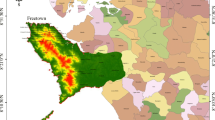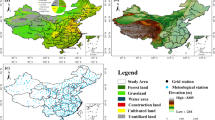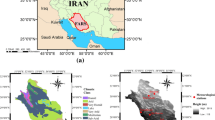Abstract
Agricultural drought, a common phenomenon in most parts of the world, is one of the most challenging natural hazards to monitor effectively. Land surface water index (LSWI), calculated as a normalized ratio between near infrared (NIR) and short-wave infrared (SWIR), is sensitive to vegetation and soil water content. This study examined the potential of a LSWI-based, drought-monitoring algorithm to assess summer drought over 113 Oklahoma Mesonet stations comprising various land cover and soil types in Oklahoma. Drought duration in a year was determined by the number of days with LSWI <0 (DNLSWI) during summer months (June–August). Summer rainfall anomalies and LSWI anomalies followed a similar seasonal dynamics and showed strong correlations (r 2 = 0.62–0.73) during drought years (2001, 2006, 2011, and 2012). The DNLSWI tracked the east-west gradient of summer rainfall in Oklahoma. Drought intensity increased with increasing duration of DNLSWI, and the intensity increased rapidly when DNLSWI was more than 48 days. The comparison between LSWI and the US Drought Monitor (USDM) showed a strong linear negative relationship; i.e., higher drought intensity tends to have lower LSWI values and vice versa. However, the agreement between LSWI-based algorithm and USDM indicators varied substantially from 32 % (D 2 class, moderate drought) to 77 % (0 and D 0 class, no drought) for different drought intensity classes and varied from ∼30 % (western Oklahoma) to >80 % (eastern Oklahoma) across regions. Our results illustrated that drought intensity thresholds can be established by counting DNLSWI (in days) and used as a simple complementary tool in several drought applications for semi-arid and semi-humid regions of Oklahoma. However, larger discrepancies between USDM and the LSWI-based algorithm in arid regions of western Oklahoma suggest the requirement of further adjustment in the algorithm for its application in arid regions.













Similar content being viewed by others
References
Arndt DS, Basara JB, McPherson RA, Illston BG, McManus GD, Demko DB (2009) Observations of the overland reintensification of tropical storm Erin (2007). Bull Am Meteorol Soc 90:1079–1093
Bajgain R, Xiao X, Wagle P, Basara J, Zhou Y (2015) Sensitivity analysis of vegetation indices to drought over two tallgrass prairie sites. ISPRS J Photogramm Remote Sens 108:151–160
Basara JB, Maybourn JN, Peirano CM, Tate JE, Brown PJ, Hoey JD, Smith BR (2013) Drought and associated impacts in the Great Plains of the United States—a review. Int J Geosci 4:72
Brock FV, Crawford KC, Elliott RL, Cuperus GW, Stadler SJ, Johnson HL, Eilts MD (1995) The Oklahoma Mesonet: a technical overview. J Atmos Ocean Technol 12:5–19
Ceccato P, Flasse S, Gregoire J-M (2002) Designing a spectral index to estimate vegetation water content from remote sensing data: part 2. Validation and applications. Remote Sens Environ 82:198–207
Ceccato P, Flasse S, Tarantola S, Jacquemoud S, Grégoire J-M (2001) Detecting vegetation leaf water content using reflectance in the optical domain. Remote Sens Environ 77:22–33
Chandrasekara K, Saia MS, Beheraa G (2011) Assessment of early season agricultural drought through land surface water index (LSWI) and soil water balance model. ISPRS-International Archives of the Photogrammetry, Remote Sensing and Spatial Information Sciences 3820:50–55
Christian J, Christian K, Basara JB (2015) Drought and pluvial dipole events within the great plains of the United States. J Appl Meteorol Climatol 54:1886–1898
Dong X et al. (2011) Investigation of the 2006 drought and 2007 flood extremes at the Southern Great Plains through an integrative analysis of observations. J Geophys Res Atmos 116(D3). doi:10.1029/2010JD014776
Gamon JA et al. (1995) Relationships between NDVI, canopy structure, and photosynthesis in three Californian vegetation types. Ecol Appl:28–41
Gamon JA, Field CB, Roberts DA, Ustin SL, Valentini R (1993) Functional patterns in an annual grassland during an AVIRIS overflight. Remote Sens Environ 44:239–253
Hoerling M et al. (2013) Anatomy of an extreme event. J Clim 26:2811–2832
Hulse JH, Escott VJ (1986) Drought–inevitable and unpredictable the pattern and consequences of recurrent drought interdisciplinary. Science Reviews 11:346–358
Hunt ER, Rock BN, Nobel PS (1987) Measurement of leaf relative water content by infrared reflectance. Remote Sens Environ 22:429–435
Jackson R, Slater P, Pinter P (1983) Discrimination of growth and water stress in wheat by various vegetation indices through clear and turbid atmospheres. Remote Sens Environ 13:187–208
Jensen JR (2009) Remote sensing of the environment: an Earth resource perspective. Pearson Education, New Delhi
Kogan F (2002) World droughts in the new millennium from AVHRR-based vegetation health indices. Eos Transactions American Geophysical Union 83:557–563
Kogan F, Stark R, Gitelson A, Jargalsaikhan L, Dugrajav C, Tsooj S (2004) Derivation of pasture biomass in Mongolia from AVHRR-based vegetation health indices international. Journal of Remote Sensing 25:2889–2896
Lillesand T, Kiefer RW, Chipman J (2014) Remote sensing and image interpretation. Wiley, New York
Liu L, Hong Y, Bednarczyk CN, Yong B, Shafer MA, Riley R, Hocker JE (2012) Hydro-climatological drought analyses and projections using meteorological and hydrological drought indices: a case study in Blue River basin. Oklahoma Water Resources Management 26:2761–2779
Maki M, Ishiahra M, Tamura M (2004) Estimation of leaf water status to monitor the risk of forest fires by using remotely sensed data. Remote Sens Environ 90:441–450
Mallya G, Zhao L, Song X, Niyogi D, Govindaraju R (2013) 2012 Midwest drought in the United States. J Hydrol Eng 18:737–745
Mizzell HP, Lakshmi V (2003) Integration of science and policy during the evolution of South Carolina’s drought program water: science, policy, and management: challenges and opportunities 311–339
Nicholson SE (1989) Long-term changes in African rainfall. Weather 44:46–56
Nicholson SE (2000) The nature of rainfall variability over Africa on time scales of decades to millenia. Glob Planet Chang 26:137–158
Otkin JA, Shafer M, Svoboda M, Wardlow B, Anderson MC, Hain C, Basara J (2015) Facilitating the use of drought early warning information through interactions with agricultural stakeholders. Bull Am Meteorol Soc 96:1073–1078
Shahid S, Behrawan H (2008) Drought risk assessment in the western part of Bangladesh. Nat Hazards 46:391–413
Sönmez FK, Koemuescue AU, Erkan A, Turgu E (2005) An analysis of spatial and temporal dimension of drought vulnerability in Turkey using the standardized precipitation index. Nat Hazards 35:243–264
Svoboda M et al. (2002) The drought monitor. Bull Am Meteorol Soc 83:1181–1190
Tadesse T, Wardlow BD, Brown JF, Svoboda MD, Hayes MJ, Fuchs B, Gutzmer D (2015) Assessing the vegetation condition impacts of the 2011 drought across the US southern Great Plains using the vegetation drought response index (VegDRI). J Appl Meteorol Climatol 54:153–169
Tian Y, Zhou L, Romanov P, Yu B, Ek M 2013 Comparison of Amazon and central Africa tropical vegetation dynamics using SEVIRI data from 2009 to 2011. In: EGU General Assembly Conference Abstracts. p 6535
United States Department of agriculture farm service agency (USDA-FSA) (2015) Noninsured crop cisaster assistance program (NAP). http://www.fsa.usda.gov/Internet/FSA_File/ccc0471_nap_bp_140813v01.pdf. Acessed July 2016
Wagle P et al. (2014) Sensitivity of vegetation indices and gross primary production of tallgrass prairie to severe drought. Remote Sens Environ 152:1–14
Zhang X, Nearing M (2005) Impact of climate change on soil erosion, runoff, and wheat productivity in central Oklahoma. Catena 61:185–195
Acknowledgments
This study was supported in part by a research grant (Project No. 2012-02355) through the USDA National Institute for Food and Agriculture (NIFA)’s Agriculture and Food Research Initiative (AFRI), Regional Approached for Adaptation and Mitigation of Climate Variability and Change grant (IIA-1301789), NOAA Climate Office’s Sectoral Applications Research Program (SRP) grant NA130AR4310122, and Oklahoma’s taxpayers fund for the Oklahoma Mesonet through the Oklahoma State Regents for Higher Education and the Oklahoma Department of Public Safety. We would also like to acknowledge the National Drought Mitigation Center at the University of Nebraska-Lincoln, the US Department of Agriculture, and the National Oceanic and Atmospheric Administration for the dataset.
Author information
Authors and Affiliations
Corresponding author
Electronic supplementary material
Table S1
(DOCX 42 kb)
Rights and permissions
About this article
Cite this article
Bajgain, R., Xiao, X., Basara, J. et al. Assessing agricultural drought in summer over Oklahoma Mesonet sites using the water-related vegetation index from MODIS. Int J Biometeorol 61, 377–390 (2017). https://doi.org/10.1007/s00484-016-1218-8
Received:
Revised:
Accepted:
Published:
Issue Date:
DOI: https://doi.org/10.1007/s00484-016-1218-8




